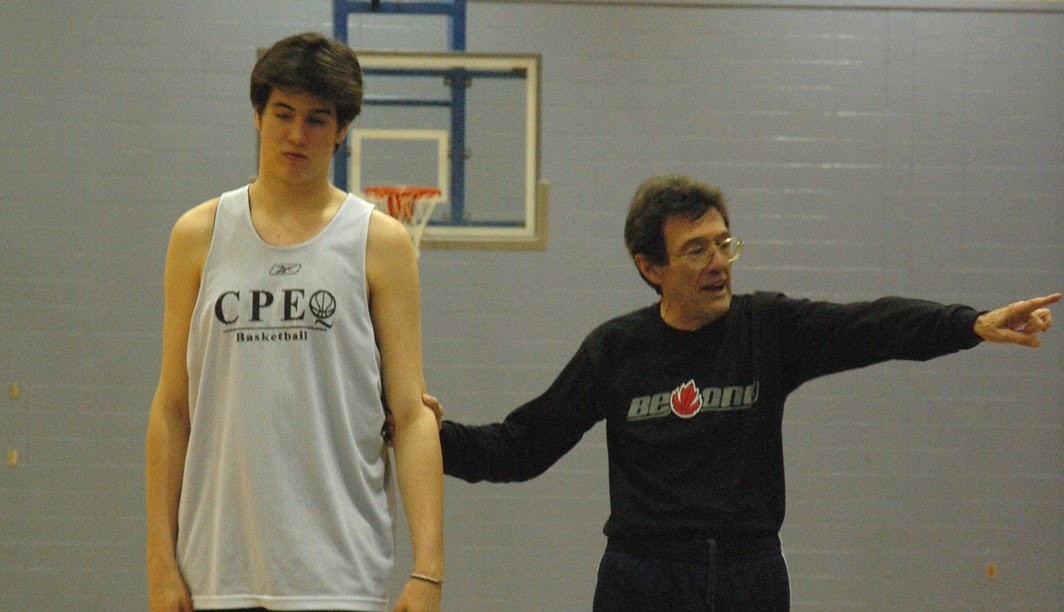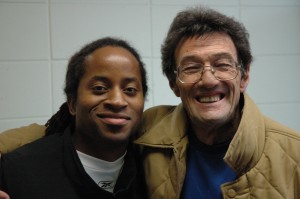
The teacher-coach that I am now is substantially different from who I was in the 1990s and early 2000s.
When asked recently why that is, the response comes easily: Mario DeSisti.
Granted I’ve had a number of basketball mentors (see: Mike MacKay) who have had – and continue to have – a profound impact on how I think about the game. But it was during the spring of 2004 when I, along with 18 other coaches across Canada, was selected to participate in an FIBA/IOC coach certification course in Halifax, Nova Scotia.
DeSisti was the master teacher for that course. And, none of us had any clue about the mental — and sometimes physical — affront that we would endure over that week long course. To say he rattled the cage and forced you to have a reason behind *everything* you did, would be putting it mildly.
You could hear him bellow in his broken English: “Whhhhhhyyyyyy?! Why you do that?”
Or, “Noooo! That makes no sense. Why!?!”
Or, what struck the deepest cord in me: “Practice must read like a book…!”
Like many good teachers, one often doesn’t appreciate what they’re giving to you until after the fact. It’s taken me a long time to digest his many lessons and teaching points. And, I’m only now beginning to put it all together.
Here’s a top-25 list of teaching points that Mike MacKay put together from Mario DeSisti’s time with Canada Basketball…
Top 25 Basketball Teaching Points
[1] You need to have a “teaching mentality”.
Give two options controlled by guided defense. If you want players to learn the game we must teach it in every drill. By using guided defense the offense learns the reason why they are doing what they are doing. It also helps defense become smarter. Understanding how defense can influence offensive decisions is a very important concept.
[2] If you have two (2) options in decision making, stay on offense three (3) times in a row.
Guided defense gives you option 1, option 2 and then the athletes makes a choice on the third. By staying on offense multiple reps, you get a chance to immediately learn from the rep before.
[3] Add another option… when the first two (2) options have been consolidated.
Don’t add the third option until the basketball player shows they can execute their skills against the first two.
[4] Add transition for conditioning and concentration.
- Defense transitions vs. air i.e. 1-on-0, 2-on-0 etc.
- Defense transition vs. offense 1-on-1, 3-on-3
- Offense transition vs. new offensive 1-on-1 on-1, 3-on-3-on-3
[5] Teach offense the first three (3) months…
…next three (3) months = 70% defense 30% offense
…last 2 months = 40% transition, 30% offense, 30% defense.
[6] Use “flying corrections”.
Make corrections, as much as possible, without stopping the drill. If one player is having problems pull the out of the drill and give your correction. Don’t stop the drill for everyone because of the error of one individual.
[7] Use visual signals to force players to react.
The coach should make the players read situations by giving signals that force players to react (e.g. a number, an arm up to indicate a dribble, showing two hands to call for a pass.)
[8] Have continuity in each basketball practice.
It is hard for players to follow if you jump from drill to drill with no logical progression. Practice is like reading a book. Start with the introduction and proceed to chapter 1 then 2, 3 etc. You don’t start at chapter 5, and then go to 1 then 7 etc.
[9] If you have a shot clock in the basketball game you must practice with one.
Even if it is a 10-second call by the coach. Players need to learn to adapt. What do you want to happen at 10 seconds? The athletes need to know to attack at about 8 seconds.
[10] If you don’t have a center, don’t play with a center.
Don’t force players to fit a system that does not promote development. You don’t want a lawsuit because we did not allow a player to develop the skills necessary to play at the next level. In school we teach [academic] ‘skills’ so player can be promoted to the next level [grade level]. This isn’t happening in basketball.
[11] Avoid running too many old offenses and teaching old* offensive concepts.
Many [offensive strategies] pre-date the shot clock and the new physicality of today’s defenses. We need to create problems in drills so the athletes can learn recovery. Spacing and movement are key [as is] making use of the contact by the defense. [When there is] no penetration, no movement, no continuous picks or screens into picks, [it is] very easy for today’s defenses to defend. The chest pass is an “old” pass yet is the first taught and most used in drills where no defense is prevalent. It’s almost impossible to use in today’s game.
[12] Make use of your assistant coaches.
Give them specific things to do. Debrief with assistants before practice as to what will be done that day. Have them take notes in practice. What corrections they had to make. You want assistants to ask to do things rather then you tell them to do things. Make assistants think about the why. When they have a suggestion, they should tell you why he thinks this is a good thing to do. Let players know which assistant will be working with them that day in practice. Who is in charge in each drill?
[13] When scouting your opponent…
Who passes to the centre? What happens when the ball is in the post? What type of screens does the team run? What zone do they play? Who are the shooters?
[14] A basketball player on the perimeter is only denied when…
A player is denied when the elbow of the defender is in the passing lane (i.e. the line between the passer and receiver). A hand is not denying. Pass high outside and the offense will move to get the ball. Also, an offensive player can step through the hand to get the ball. Cannot step through an elbow.
[15] Teach to teach.
Be fussy. Make corrections. If you don’t make correction when the players are young you will never be able to make them when older.
[16] Keep the same basketball drill and add to it.
Instead of changing drill formation all the time. This allows players to concentrate on learning the concept not the drill.
Also, be sure to give multiple reps—back-to-back—while working on reads and timing.
Utilize your players as passers or as guided defense in drills. Their job is to help the others learn.
[17] Never pass back without penetration first.
Must force the defense to help first. Dangerous pass without penetration.
[18] Practice at tournaments.
Do a lot of shooting, but no running. One (1) day before the tournament, have a light(er) practices. Two (2) days before, go hard.
[19] No easy 3-point shots.
There’s no help for a 3-point shot. It has changed the game. The more players who can shoot it the more dangerous that your team is going to be.
[20] Defensive responsibility on penetration.
The first dribble is the responsibility of the ball defender (i.e. work to prevent straight-line penetration at the basket). The second dribble is the helpside defender’s responsibility.
[21] Scouting reports…
Professionals watch video, juniors scout players, go through the types of screens you will see. Who passes to the centre? Be aggressive on that passer. Work mostly 2-on-2, 3-on-3 not 5-on-5.
[22] You cannot cure details if you skip around in practice.
One offense, one defensive drill. Stay consistent. Finish the offensive book before you start your defensive book.
[23] Don’t teach dirty tactics.
Plain and simple.
[24] Reward good defensive players.
Start them. Have good offensive players come off the bench.
[25] Start in odd formations and flow into a drill.
This forces the players to move into positions, which are more game like.
Grazie mille, Mario…! You shone a light on a new path that has awakened new possibilities – both for me and all that I’m able to (equally) infect.
/sef.
